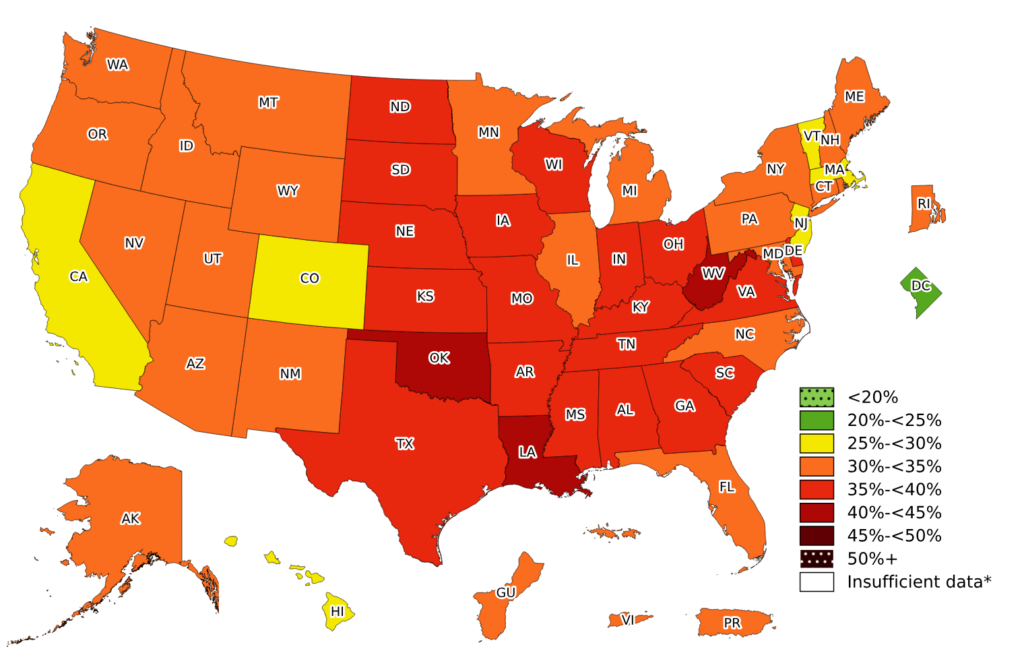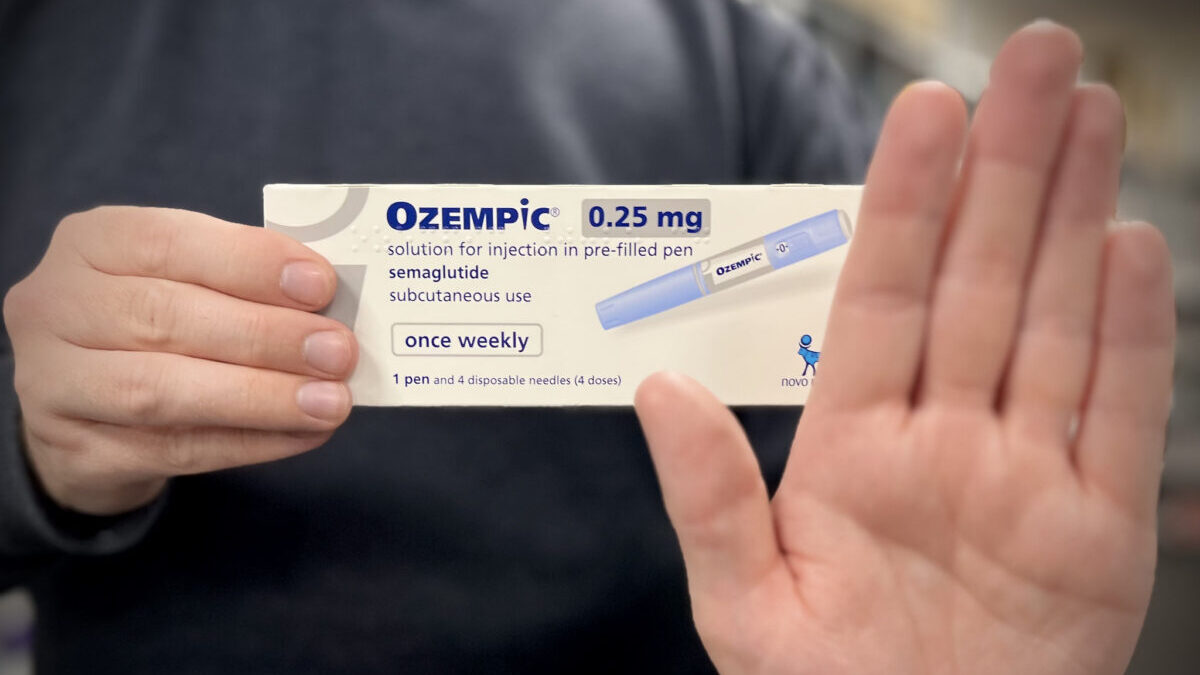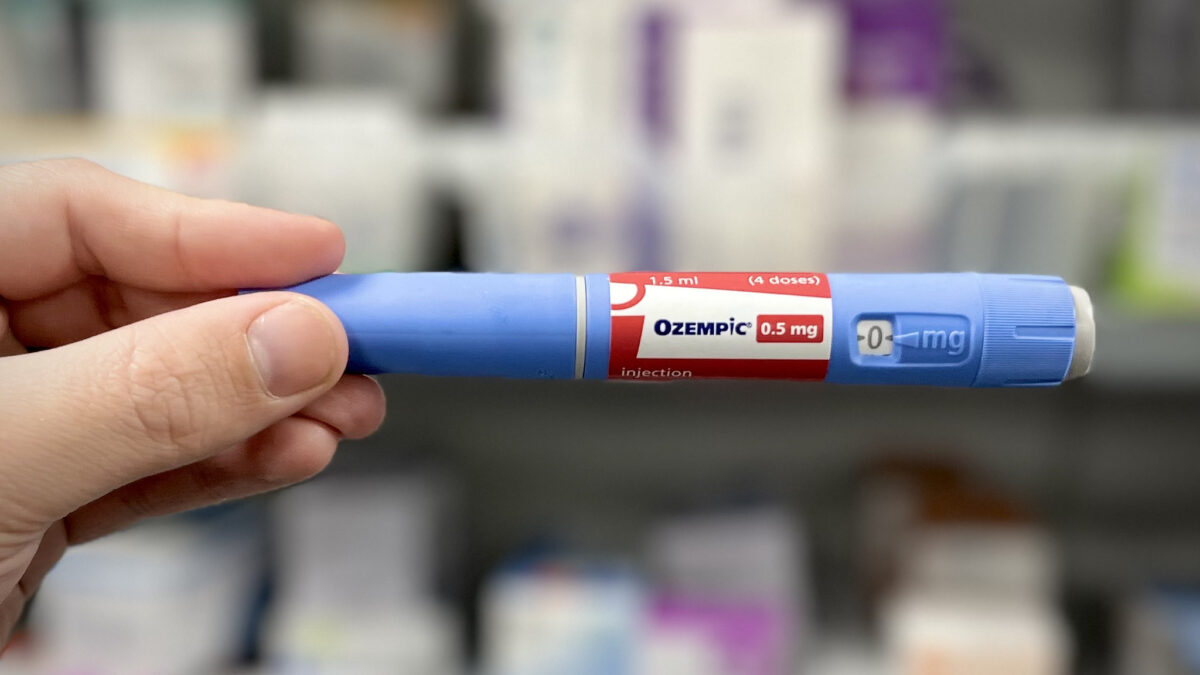America is losing the fight against obesity. In desperation, Americans are getting hooked on a new kind of 21st century diet pill engineered to capitalize on the crisis.
The latest health craze to sweep the nation features new injections for a preventable condition that already has a cure. Semaglitude, a popular type 2 diabetes medication, is being prescribed off-label to patients eager to lose weight.
The pharmaceutical solution being sold as a “miracle” cure to runaway obesity has become such a blockbuster success that the weight-loss drugs are “reshaping Denmark’s economy.” Denmark is home to the manufacturers of two name-brand obesity medicines, Ozempic and Wegovy.
New maps from the Centers for Disease Control (CDC) released last week underscored both the severity of the obesity crisis and the scale of the opportunity to profit from it. Every single state and territory now has at least a 20 percent obesity rate. Three states, Oklahoma, Louisiana, and West Virginia, have populations where at least 40 percent of residents are obese. At least 35 percent of residents are obese in 19 other states.

About 33 percent of American adults 18 and older are categorically obese, and another 34 percent are overweight. A decade after the launch of Michelle Obama’s “Let’s Move” campaign, about 1 in 5 children have already reached the same deadly metabolic milestone, a rate that’s tripled over 30 years. Individuals who are at an otherwise standard weight are in the minority, and have been for some time.
The obesity epidemic is associated with an unprecedented outbreak of chronic disease, leaving the nation fat, sick, and depressed. Obesity is linked to high blood pressure, diabetes, heart disease, stroke, gallbladder disease, osteoarthritis, sleep apnea, mental illness, and many types of cancer, just to name a few.
The CDC estimates 6 in 10 Americans already have at least one chronic illness. Four in 10 have two or more. People who are obese can expect to pay double in health care costs over their lifetime. Those costs triple and quadruple as weight gain accelerates.
Put simply, there is far more money to be made on a population chronically obese than one at an otherwise healthy weight. Ozempic, meanwhile, is a medication that can exploit the desire for weight loss without solving the crisis. A spring report from The Wall Street Journal noted patients who quit taking Ozempic often see their weight go back up.
“Patient testimonies have focused not only on the dramatic effect on their waistlines, but also on how quickly many seem to pack the pounds back on if they stop taking the injections,” the report read. “That may not be ideal for patients, but for Wall Street it is a feature rather than a bug.”
On the other hand, remaining on Ozempic brings consequences of its own. A study from 2020 that examined patients who took once-weekly injections over a 52-week period found that while users of Semaglitude lost 7.4 pounds of fat, they also lost 5 pounds of muscle. It’s hard to describe a weight loss drug where 40 percent of the weight lost is muscle as some kind of “miracle” elixir.
The study was even funded by Novo Nordisk, the Danish company behind Ozempic. Novo Nordisk is now being sued alongside other weight-loss drug manufacturers over allegations their medicines have caused stomach paralysis.
Ozempic’s website lists nausea, diarrhea, stomach pain, vomiting, and constipation as possible side effects. The medication has reportedly led to a spike in emergency room visits with patients suffering blurred vision, pancreatitis, malnutrition, and drooping faces. There’s even a new term to describe the latter: “Ozempic Face.”
In November, New York Magazine’s The Cut offered a blunt feature on the new weight-loss warning in the headline, “You Might Go Through Hell for You Post-Ozempic Body.” Considering 40 percent of weight lost, on average, is muscle, it might not even be a healthy one.
Despite the risks, the American Academy of Pediatrics (AAP) published new guidelines on treating childhood obesity aimed at pumping more money into expensive temporary fixes. The updated guidelines published in January recommend children as young as 12 be prescribed Ozempic to treat weight gain.
[READ: Forget Playing Outside: Big Pharma’s Solution To Childhood Obesity Is More Drugs]
Surrogates for the medication, meanwhile, are promoting the weight loss drugs, with their own profits from manufacturers flying under the radar.
“Media outlets have consistently failed to report on the associated risks and potential conflicts of interest among the experts they feature,” reported independent Substack journalist Lee Fang on Tuesday.
For instance, in the ongoing debate concerning insurance coverage for Ozempic, which currently costs approximately $1,350 per month, an ABC News story quoted only one physician, Dr. Deborah Horn, who advocated for Medicare to cover the medication. However, the article omitted that Horn has received nearly a quarter of a million dollars from Novo Nordisk since 2020.
The American obesity epidemic has remained an ongoing battle for decades. Hampered by bad science leading Americans to obsess over calories and pursue low-fat, high carb diets, obesity exploded from just 13 percent of U.S. adults in 1962 to more than 1 in 3 today.
Fat storage, however, is determined by complex interactions between hormones and enzymes and dictated by the quality of our diet. Contrary to federal nutrition guidelines affected by the food industry, optimal metabolic health achieved with a minimally processed high-fat, low carb diet complete with an exercise regimen is one long-lasting antidote to obesity.
Last fall, the Food and Drug Administration (FDA) finally proposed an update to the agency’s definition of “healthy,” which would promote foods such as salmon with higher amounts of saturated fat over ultra-processed cereals. The solution to the obesity epidemic rests far more in re-engineering the American diet than the pharmaceuticals manufactured to profit from the crisis. Our health crises are foodable, not druggable.









